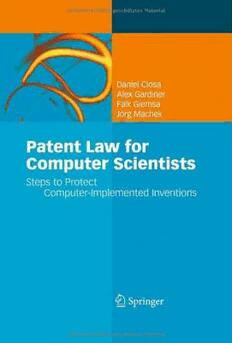Table Of ContentPatent Law for Computer Scientists
Daniel Closa Alex Gardiner Falk Giemsa
l l
Jo¨rg Machek
Patent Law for
Computer Scientists
Steps to Protect
Computer-Implemented Inventions
DanielClosa
AlexGardiner
FalkGiemsa
Jo¨rgMachek
EuropeanPatentOffice,Munich
[email protected]
ACMComputingClassification(1998):K.5.1,K.4.1,J.1
ISBN:9783642050770 eISBN:9783642050787
DOI10.1007/9783642050787
SpringerHeidelbergDordrechtLondonNewYork
LibraryofCongressControlNumber:2009940399
#SpringerVerlagBerlinHeidelberg2010
Thisworkissubjecttocopyright.Allrightsarereserved,whetherthewholeorpartofthematerialis
concerned,specificallytherightsoftranslation,reprinting,reuseofillustrations,recitation,broadcasting,
reproductiononmicrofilmorinanyotherway,andstorageindatabanks.Duplicationofthispublication
orpartsthereofispermittedonlyundertheprovisionsoftheGermanCopyrightLawofSeptember9,
1965,initscurrentversion,andpermissionforusemustalwaysbeobtainedfromSpringer.Violations
areliabletoprosecutionundertheGermanCopyrightLaw.
Theuseofgeneraldescriptivenames,registerednames,trademarks,etc.inthispublicationdoesnot
imply,evenintheabsenceofaspecificstatement,thatsuchnamesareexemptfromtherelevantprotec
tivelawsandregulationsandthereforefreeforgeneraluse.
Coverdesign:KuenkelLopkaGmbH,Heidelberg,Germany
Printedonacidfreepaper
SpringerispartofSpringerScience+BusinessMedia(www.springer.com)
Preface
WeworkattheEuropeanPatentOffice(EPO).Threeofusarepatentexaminersand
oneisthedirectorofagroupofpatentexaminers.Patentexaminersassessapplica-
tionsforpatentswhichmaybegrantedtoinventors.Apatentisalegaltitlegiving
its holder the right to prevent third parties from commercially using an invention
withoutauthorisation.Examinerscheckinparticularthattheinventionisnewand
not some mere obvious alteration to something which already exists, by carrying
outsearchesonallsortsofinformationwhichexistedandcouldhavebeenlookedat
bytheapplicantinthetimeuptothefilingoftheirfirstapplication.Suchinforma-
tioniscollectivelyknownasthe“priorart” bythoseworkinginthe patentworld.
Patent examiners work at the forefront oftechnology and deal every day with the
latestandmostchallengingtechnicalinnovations.Wewillpresentanoverviewof
themindsetoftypicalpatentexaminers.Althoughweaimtogivegeneraladvice,a
certainbiastowardstheproceduresoftheEPOisunavoidable.
The idea underlying this book first came about when two of us participated in
writinganarticle[1]inwhichwedemonstrated,bywayofoneparticularexample,
how much technical information had to be disclosed in an application in order to
describe a technical contribution which would in turn be worthy of detailed
examination of inventive step. This article was met with general enthusiasm and
numerous remarks encouraging the authors to extend the exercise. Since then we
havebeenrepeatedlyaskedtoconsiderextendingthescopetootherspecificareas
of interest. After one of us was approached by the current publishers to present a
scheme for a more extensive treatment of such topics, we started to collect
information and to discuss, with a view to “doing a proper job” of production of
amorecompletecompilation,snippetsofpresentationsweregularlygive.
As befits a European organisation, our countries of origin are spread across
Europe. We come from Scotland, Luxemburg, France/Spain and Austria. We are
thustrulyEuropean.TheEuropeanPatentOfficeanditscivilservantshavecreated
a culture of cultures both as an organisation and within the daily lives of all
employees.Thiseveninitselfisremarkable yetonlyshortlyaftertheEuropean
Patent Organisation celebrated its 30th birthday it welcomed “The Former
v
vi Preface
Yugoslav Republic of Macedonia” as its 35th member state, on 1 January 2009
(Fig.1).Thesefirstfewdecadeshavebeenspectacular.Thenumberofapplications
filed with the European Patent Office has risen steadily, confounding the humble
expectationsofitsfoundingfathers,whowouldneverhaveguessedatthecurrent
figuresevenintheirwildestdreams.Intheearlyyearsofitsexistence,theEPOwas
dealing with around 10,000 applications a year; this was already considered a
success.In2007theEPOreceivedwellover210,000applications[2].
OnebasicreasonforthesuccessoftheEuropeanpatentsystemappearstoliein
the high economic value which is attributed to patents granted under its auspices.
This is a particularly strong motivation for getting patent applications to comply
withtheEuropeanPatentConvention(EPC)rightfromthebeginning.Inourdaily
work we have to deal with a variety of applications, some of which describe
truly splendid innovations. A relatively high proportion of them, however, will
not be granted a patent because they do not show all the important features
Fig.1 ThememberstatesoftheEuropeanPatentOrganisation(EPO)
Preface vii
necessary to satisfy our patent law. In many cases this sorry situation could have
been avoided had some basic considerations been respected. This is particularly
trueforcomputerimplementedinventions.
Together,thefourofushaveatotalexperienceof70yearsinthepatentbusiness.
From our academic background we are physicists, electronic engineers and com-
puter scientists. We are happy to tap our wealth of knowledge for this book. Our
present common centre of professional interest lies within the area of Computer
ImplementedInventions(CII).Thisalsoincludesapplicationswhicharefrequently
termed “methods for doing business”, as these are typically implemented on
computers.
This book is based on our experience within the EPO and by way of some
extension,Europemoregenerally,patentlawinEuropebeingmoreorlessharmo-
nized.NationalCourtsofJustice,whendealingwithcasesthathadbeenexamined
inthelightoftheEPCandtheEPO’sBoardsofAppeal,attempttointerpretthelaw
inaccordancewiththesamevalues,andwheredifferencesdoexisttheytendtobe
relativelyminormattersofemphasesratherthanfundamentaldifferences.
This book is a guide to examiner thinking. Despite differences in respective
patent law, the basic rationale of patent examiners is globally rather similar. The
principlesdevelopedinthisbookapplythereforealsotootherpatentsystemstoa
considerabledegree,andreferencewillregularlybemadetotheUSAandJapanese
systems.
References
1. D.Closa,P.Corcoran,J.Machek,C.Neppel;epiinformation2/2007;pp65 69
2. AlisonBrimelow:AHappyAnniversaryfortheEuropeanPatentSystem,iammagazine;http://
www.iammagazine.com/issues/Article.ashx?g=5ad0be0039524ee5aefe37d0f4e66653
Contents
PartI
1 Introduction ............................................................... 3
1.1 PatentsandSoftware,Basics ......................................... 3
1.1.1 ShortHistoryofPatents ...................................... 4
1.1.2 “Software”Patents ........................................... 8
1.1.3 OtherIntellectualPropertyRights .......................... 15
1.1.4 SomeSpectacularPatentCasesintheSoftwareField ...... 17
1.2 OverviewofPatentPracticesintheUSA,JapanandEurope ...... 20
1.2.1 ComparisonofUSPatentandTrademarkOffice,
JapanesePatentOfficeandEuropeanPatentOffice ........ 22
1.3 StructureoftheBookandPresentationofCaseMethodology ..... 29
References................................................................... 30
PartII
2 BusinessMethods ........................................................ 35
2.1 Example1:MethodofSelling ...................................... 38
2.1.1 Description .................................................. 38
2.1.2 Claim1 ...................................................... 38
2.1.3 ExaminerObservations ...................................... 39
2.2 Example2:MethodofSellingviaaNetwork ...................... 40
2.2.1 Description .................................................. 40
2.2.2 Claim2 ...................................................... 41
2.2.3 ExaminerObservations ...................................... 42
2.3 Example3:AutomaticMethodofSellingviaaNetwork .......... 43
2.3.1 Description .................................................. 43
2.3.2 Claim3 ...................................................... 44
2.3.3 ExaminerObservations ...................................... 45
ix
x Contents
2.4 Example4:AutomaticMethodofSellingviaaNetworkwith
ManagementofPowerProduction .................................. 46
2.4.1 Description .................................................. 46
2.4.2 Claim4 ...................................................... 47
2.4.3 ExaminerObservations ...................................... 48
3 AdministrativeMethods ................................................. 51
3.1 Example1:MethodofDataGathering ............................. 52
3.1.1 Description .................................................. 52
3.1.2 Claim1 ...................................................... 52
3.1.3 ExaminerObservations ...................................... 53
3.2 Example2:MethodforAssimilatingAdministrative
InformationforSettingupanAgreement ........................... 54
3.2.1 Description .................................................. 54
3.2.2 Claim2 ...................................................... 55
3.2.3 ExaminerObservations ...................................... 55
3.3 Example3:DataProcessingDeviceforAssimilating
AdministrativeInformationforSettingupanAgreement .......... 57
3.3.1 Description .................................................. 57
3.3.2 Claim3 ...................................................... 58
3.3.3 ExaminerObservations ...................................... 58
3.4 Example4:MethodofArranginganAgreement
viaEncryptedCommunicationChannels ........................... 59
3.4.1 Description .................................................. 59
3.4.2 Claim4 ...................................................... 61
3.4.3 ExaminerObservations ...................................... 61
4 DigitalRightsManagement ............................................. 63
4.1 Example1:DigitalContentPromotionMethod .................... 63
4.1.1 Description .................................................. 63
4.1.2 Claim1 ...................................................... 64
4.1.3 ExaminerObservations ...................................... 65
4.2 Example2:Computer-ImplementedContentPromotion
MethodUsingEncryption ........................................... 66
4.2.1 Description .................................................. 66
4.2.2 Claim2 ...................................................... 67
4.2.3 ExaminerObservations ...................................... 68
4.3 Example3:Client ServerDRMSystem ............................ 69
4.3.1 Description .................................................. 69
4.3.2 Claim3 ...................................................... 71
4.3.3 ExaminerObservations ...................................... 72
5 DatabaseandDatabaseManagementSystem ......................... 75
5.1 Example1:SimultaneousAccesstoaDatabase .................... 77
Contents xi
5.1.1 Description .................................................. 77
5.1.2 Claim1 ...................................................... 79
5.1.3 ExaminerObservations ...................................... 79
5.2 Example2:SimultaneousDatabaseAccesswith
TimeManagement ................................................... 80
5.2.1 Description .................................................. 80
5.2.2 Claim2 ...................................................... 82
5.2.3 ExaminerObservations ...................................... 82
5.3 Example3:SimultaneousDatabaseAccesswith
AutomaticTimeManagement ...................................... 83
5.3.1 Description .................................................. 83
5.3.2 Claim3 ...................................................... 85
5.3.3 ExaminerObservations ...................................... 86
5.4 Conclusion ........................................................... 86
6 BillingandPayment ..................................................... 89
6.1 Example1:Third-PartyBasedBillingandPaymentMethod ...... 89
6.1.1 Description .................................................. 89
6.1.2 Claim1 ...................................................... 91
6.1.3 ExaminerObservations ...................................... 92
6.2 Example2:Card-LessBillingandPaymentProcess ............... 93
6.2.1 Description .................................................. 93
6.2.2 Claim2 ...................................................... 95
6.2.3 ExaminerObservations ...................................... 95
6.3 Example3:ColourMatrixBasedBillingandPayment
System ............................................................... 97
6.3.1 Description .................................................. 97
6.3.2 Claim3 ...................................................... 98
6.3.3 ExaminerObservations ...................................... 99
References.................................................................. 101
7 GraphicalUserInterfaces .............................................. 103
7.1 Example1:Spell-CheckingSystem ............................... 105
7.1.1 Description ................................................ 105
7.1.2 Claim1 .................................................... 105
7.1.3 ExaminerObservations .................................... 105
7.2 Example2:DynamicSpell-CheckingSystem .................... 106
7.2.1 Description ................................................ 106
7.2.2 Claim2 .................................................... 107
7.2.3 ExaminerObservations .................................... 107
7.3 Example3:MixedSpell-CheckingSystem ....................... 108
7.3.1 Description ................................................ 108
7.3.2 Claim3 .................................................... 110
7.3.3 ExaminerObservations .................................... 110

